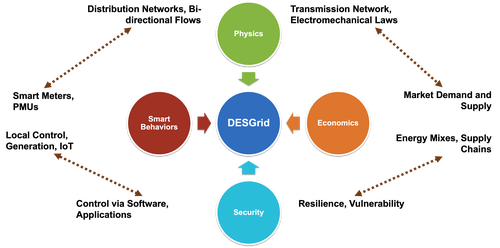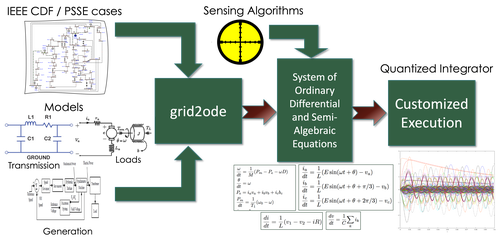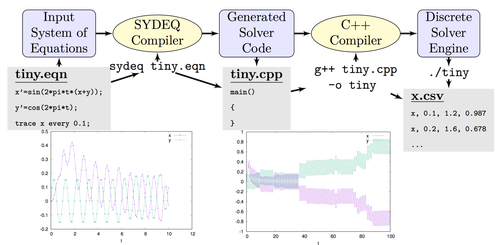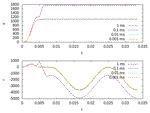DES Grid
Discrete Event Modeling of the Electric Grid is a new non-equilibrium, transient analysis model and solver that is indispensable for new advancements in grids with high renewable penetration.
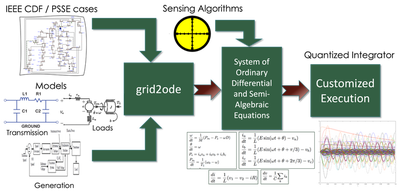
Overview
This project is aimed at creating and demonstrating a new approach to transient analysis for power systems that has three key advantages over existing methods. These advantages are:
- an accurate, physically plausible model that creates signals perceived by sensors throughout the transmission and distribution networks;
- enabling a natural and accurate representation of modern electrical loads, such as power electronics devices, within the distribution system, and
- a computationally tractable method of simulating these models at large scales.
Gallery
Approach
Grid modeling and simulation requires accurate capture of physics combined with internal and external behavioral elements. The physics includes movement of electricity at multiple scales broadly classified as transmission, distribution, and sub-distribution. This is driven by internal behaviors: generation is dictated by physics of power generators plus sophisticated controls to maintain voltage, and by consumption loads driven by a wide variety of traditional energy sinks as well as increasingly sophisticated sensors and controllers introduced by smart grid technologies. In light of advances in distributed energy resources and renewables, most aspects of transport, generation, consumption and responses are also greatly controlled by rich internal behaviors. Our approach provides support in one form or another to modeling and simulating all the aforementioned grid elements.
We approach the grid modeling and simulation problem with a first principles-based, fully generalized, transient simulation view of the grid. Our starting point is that of a new three-phase model that is equally applicable at multiple levels, spanning transmission, distribution and sub-distribution.
Our three-phase model is designed to produce voltage and current wave forms at scales in time and geographical spaces sufficient to understand system-wide dynamics resulting from localized-yet-interconnected behaviors of:
- signal processing algorithms and logic in inverters, protection devices, and other equipment that act on millisecond time scales;
- electrical and mechanical dynamics of conventional and new solar, fossil fuel, nuclear, and other power generators that evolve over tens of seconds; and
- detailed dynamics of loads that may contribute to large-scale distributed controls that counterbalance the volatility of distributed/renewable generation.
We create a new type of power system model that integrates dynamic load and generation models with a dynamic, rather than quasi-equilibrium, model of the transmission and distribution network. This new model enables relevant, simulation-based performance assessments of new sensors, such as next generation phasor measurement units and distribution-based frequency sensors, and provide an unprecedented, indispensable understanding of how sensor characteristics impact wide area control strategies.
The new model developed through this research replaces pseudo equilibrium models of transmissions and loads with dynamic elements that properly resolve the physics that transmit electrical power. With these new models it becomes possible in simulation to measure physically plausible voltage signals throughout a large power system during a transient, and to do so with complete knowledge of the events within the modeled power system that produced the observed signal. This new insight will propel advancing sensing and control technologies that would be infeasible to engineer with present, inadequate models and experimental test beds.
Organization
- Sponsor: US Department of Energy (DOE)
- Office: Office of Electricity (OE)
- Program:
- Grid Modernization Laboratory Consortium (GMLC)
- Advanced Grid Modeling (AGM)
- Prime: Oak Ridge National Laboratory (ORNL)
Additional Motivation
Current methods for electromechanical transient analysis of electrical power systems predate the significant, recent advances in sensing technology that allow measurements of frequency to be made through the transmission and distribution systems. Consequently, current methods of analysis make no attempt to accurately calculate the signals that these sensors are designed to monitor. This creates considerable difficulties when current methods, models, and simulation tools are used to assess how a new device that relies on measures of frequency will affect the response of the power system to a disturbance,
This problem has been widely recognized in recent years, and numerous, essentially ad hoc, solutions have been proposed. While these ad hoc techniques can, and have, been easily integrated into existing tools, they generally lack a fundamental basis in the physics of an electrical power system, are prone to large numerical errors, or both. At best, these proposals must be viewed as a stop gap measure until models become available that properly resolve dynamical effects in the transmission network that, in conjunction with the generator dynamics, ultimately determine how a signal is perceived by a sensor within the transmission and distribution systems.
